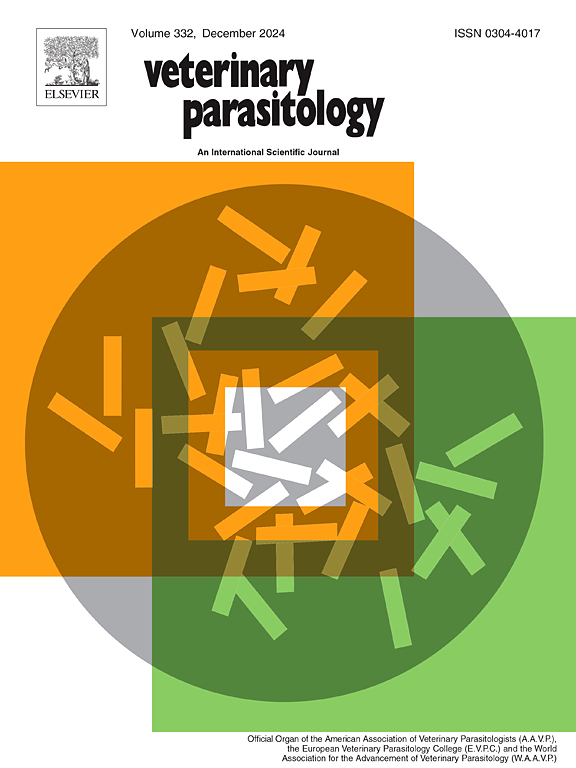Serological detection of Trypanosoma evansi infection in cattle using an in vitro cultivated antigen for indirect-ELISA in Thailand
IF 2
2区 农林科学
Q2 PARASITOLOGY
引用次数: 0
Abstract
Trypanosoma evansi is a hemoflagellate protozoan primarily transmitted by blood-sucking insects, causing significant economic losses in livestock across Southeast Asia, Africa and South America, with seroprevalence ranging from 0 % to more than 80 %. In Thailand, most livestock infections are asymptomatic, making diagnosis and disease control challenging. The WOAH recommends using an iELISA with WCLAs for detecting latent infection. However, this method relies on experimental animals to produce antigens, leading to complexity, high costs, and ethical concerns. To address this, the present study utilized in in vitro-produced crude antigens in an iELISA to detect anti-T. evansi antibodies in cattle and compare with the reference test with in vivo T. evansi crude antigen. Examination of total 778 serum samples revealed individual and herd-level seroprevalence rates of 20.05 % and 60 %, respectively, indicating significant exposure to T. evansi. Seroprevalence varied geographically, with the highest rate in Suphanburi province and no cases detected in Tak and Ubon Ratchathani provinces. Multivariable logistic regression analysis showed that cattle from the central and northern regions had higher seroprevalence rates than those from the northeastern region, likely due to differences in vector distribution, farming practices, or environmental conditions. The iELISA using in vitro-produced antigens demonstrated comparable performance to in vivo-produced antigens (k = 0.500), confirming its potential as a reliable diagnostic tool. This study is the first to use in vitro-cultured T. evansi antigens for antibody detection in small-scale Thai livestock farms. The method offers several advantages, including improved standardization, cost-effectiveness, and ethical benefits by replacing the need for live animals in antigen production. The findings of this study provide essential information on the seroprevalence of T. evansi and associated risk factors in cattle in Thailand, thereby contributing to improved disease surveillance and control strategies.
用体外培养抗原间接elisa法检测泰国牛伊文氏锥虫感染的血清学研究
伊文氏锥虫是一种主要由吸血昆虫传播的带血鞭毛的原生动物,在东南亚、非洲和南美洲造成了重大的牲畜经济损失,其血清阳性率从0 %到80 %以上不等。在泰国,大多数家畜感染是无症状的,这给诊断和疾病控制带来了挑战。世界卫生组织建议使用iELISA和WCLAs来检测潜伏感染。然而,这种方法依赖于实验动物来产生抗原,导致复杂性、高成本和伦理问题。为了解决这个问题,本研究利用体外产生的粗抗原在elisa中检测抗t。并与体内伊文氏体粗抗原对照试验进行比较。对总共778份血清样本的检查显示,个体和群体水平的血清阳性率分别为20.05 %和60 %,表明明显暴露于伊氏弓形虫。血清患病率因地区而异,素潘武里省的发病率最高,德省和乌汶拉差他尼省未发现病例。多变量logistic回归分析显示,中部和北部地区的牛血清阳性率高于东北部地区,这可能是由于病媒分布、耕作方式或环境条件的差异。使用体外产生抗原的iELISA表现出与体内产生抗原相当的性能(k = 0.500),证实了其作为可靠诊断工具的潜力。这项研究是首次在泰国小规模牲畜养殖场中使用体外培养的伊氏T.抗原进行抗体检测。该方法具有几个优点,包括改进的标准化、成本效益和伦理利益,因为它取代了在抗原生产中对活体动物的需求。本研究的结果提供了有关泰国牛伊凡斯弧菌血清患病率和相关危险因素的基本信息,从而有助于改进疾病监测和控制战略。
本文章由计算机程序翻译,如有差异,请以英文原文为准。
求助全文
约1分钟内获得全文
求助全文
来源期刊

Veterinary parasitology
农林科学-寄生虫学
CiteScore
5.30
自引率
7.70%
发文量
126
审稿时长
36 days
期刊介绍:
The journal Veterinary Parasitology has an open access mirror journal,Veterinary Parasitology: X, sharing the same aims and scope, editorial team, submission system and rigorous peer review.
This journal is concerned with those aspects of helminthology, protozoology and entomology which are of interest to animal health investigators, veterinary practitioners and others with a special interest in parasitology. Papers of the highest quality dealing with all aspects of disease prevention, pathology, treatment, epidemiology, and control of parasites in all domesticated animals, fall within the scope of the journal. Papers of geographically limited (local) interest which are not of interest to an international audience will not be accepted. Authors who submit papers based on local data will need to indicate why their paper is relevant to a broader readership.
Parasitological studies on laboratory animals fall within the scope of the journal only if they provide a reasonably close model of a disease of domestic animals. Additionally the journal will consider papers relating to wildlife species where they may act as disease reservoirs to domestic animals, or as a zoonotic reservoir. Case studies considered to be unique or of specific interest to the journal, will also be considered on occasions at the Editors'' discretion. Papers dealing exclusively with the taxonomy of parasites do not fall within the scope of the journal.
 求助内容:
求助内容: 应助结果提醒方式:
应助结果提醒方式:


